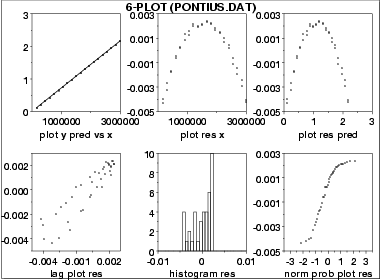1.3. EDA Techniques
1.3.3. Graphical Techniques: Alphabetic
1.3.3.33. 6-Plot
Graphical Model Validation
The 6 plots are:
- Scatter plot of the response and predicted values versus the independent variable;
- Scatter plot of the residuals versus the independent variable;
- Scatter plot of the residuals versus the predicted values;
- Lag plot of the residuals;
- Histogram of the residuals;
- Normal probability plot of the residuals.

This 6-plot of the PONTIUS.DAT data set, which followed a linear fit, shows that the linear model is not adequate. It suggests that a quadratic model would be a better model.
6 Component Plots
- Response and predicted values
- Vertical axis: Response variable, predicted values
- Horizontal axis: Independent variable
- Residuals versus independent variable
- Vertical axis: Residuals
- Horizontal axis: Independent variable
- Residuals versus predicted values
- Vertical axis: Residuals
- Horizontal axis: Predicted values
- Lag plot of residuals
- Vertical axis: RES(I)
- Horizontal axis: RES(I-1)
- Histogram of residuals
- Vertical axis: Counts
- Horizontal axis: Residual values
- Normal probability plot of residuals
- Vertical axis: Ordered residuals
- Horizontal axis: Theoretical values from a normal N(0,1) distribution for ordered residuals
- Are the residuals approximately normally distributed with a fixed location and scale?
- Are there outliers?
- Is the fit adequate?
- Do the residuals suggest a better fit?
Validating Model
-
\[ Y_{i} = f(X_{i}) + E_{i} \]
- random drawings (i.e., independent);
- from a fixed distribution;
- with fixed location; and
- with fixed variation.
Assessing the validity and quality of the fit in terms of the above assumptions is an absolutely vital part of the model-fitting process. No fit should be considered complete without an adequate model validation step.
Non-Linear Least Squares
Scatter Plot
Run Sequence Plot
Lag Plot
Normal Probability Plot
Histogram

